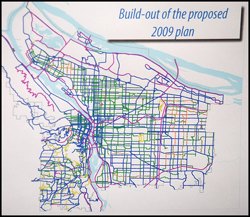
If you have something to say about the Portland Bicycle Plan for 2030 (a.k.a. the Bicycle Master Plan), Sunday (11/8) is your last chance to do it.
PBOT will take all comments received by Sunday night and try to work them into revisions of the Plan before it is finalized and goes in front of City Council for official adoption on January 20th (you can also show up to City Hall to testify on that day).
The 118 page Plan (download the whole thing or parts of it here) was over two years in the making and it will help dictate how our bikeway network is built out for the next 20 years.
So far, it has been generally well-supported, but we have also heard some criticisms and suggestions on how to make it better.
Off-street trail advocates have made their voices heard, calling on PBOT to put more emphasis and priority on facilities like the yet-to-be-built Sullivan’s Gulch and North Portland Greenway trails.
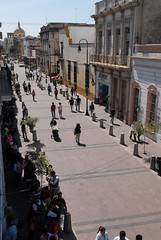
enough to lead to carfree districts
like this one in Guadalajara?
(Photos © J. Maus)
We’re likely to see some revisions in the plan to acknowledge their input, but for PBOT, these trail plans are simply not developed enough (yet) to warrant higher priority. Sullivan’s Gulch goes through right-of-way that is owned by a railroad company that is under no obligation to relinquish it. It is also extremely expensive from PBOT’s budget-strapped perspective, costing an estimated $7.7 million per mile.
Trails are also not PBOT’s jurisdiction. Even though they are increasingly considered as transportation corridors, off-street paths are managed by the Parks Bureau. This lack of a clear champion within the bureaucracy is a rightful concern of trail advocates.
On a similar note, others have said the plan focuses too much on bicycle boulevards and should instead create a network of cycle tracks on main streets and in commercial districts.
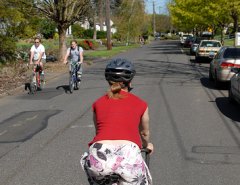
PBOT likes cycle tracks, but they don’t think the political will exists yet to be aggressively implement them. Cycle tracks are expensive and require tricky political balancing acts like removing parking and motor vehicle lanes in dense commercial zones (where business owners have traditionally been difficult to win over). For PBOT, cycle tracks aren’t just politically difficult, they are also not fully embraced by “the bike community” they are meant to serve, and it’s much easier for PBOT to do bike projects that have overwhelming support.
Instead of getting too far out in front with cycle tracks, PBOT wants to “build the constituency” with bike boulevards (not like the pseudo-boulevards we have today, but real, developed bike streets where it’s obvious that bike traffic has been prioritized — like we hope the ones being built on on SE Spokane and N Going Streets will turn out).
According to PBOT, the bike boulevards will lead to higher bike usage, which will then build the constituency necessary to push for more bold and difficult treatments like cycle tracks.
In a blog post last night, local transportation thinker (and Planning Commissioner) Chris Smith refers to this debate about bike boulevards and cycle tracks as either going “broad or deep”.
I think it’s a mistake to see this as an either/or situation. Obviously, given that they’ve already installed one cycle track downtown, the City is keen on doing more of them and I’d be shocked if we don’t new ones pop up soon (or, more likely, see the PSU/Broadway one extended). So, while the plan puts an emphasis on bicycle boulevards, it’s likely that PBOT will take a flexible approach as funding opportunities arise.
But will those opportunities arise? Is PBOT going to put their money where their mouths are?
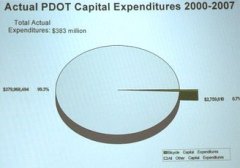
PBOT spends on bikes.
The Portland Mercury published a feature story this week drawing attention to the fact that while the plan looks to make bicycles a “pillar” of the transportation system, it still only commits about 1% of it’s budget to funding them.
The Bicycle Transportation Alliance (BTA), Portland’s largest bike advocacy organization, is in support of the plan. They haven’t made their official comments public yet, but staffer Michelle Poyourow testified at the Planning Commission hearing on October 28th.
In that testimony, the BTA said they find the Plan’s “goals, objectives and action items to be strong”. However, they warned the Commission that those goals could only be reached if the policy proposals made by PBOT in the Plan are “explicitly — not just implicitly” incorporated into other important City planning documents.
“Create conditions that make bicycling more attractive than driving for trips of three miles or less.”
— PBOT’s proposed new language for the City’s policy on Bicycle Transportation
That’s the big win for the Bike Master Plan. There’s little doubt it will be adopted by Council; but the real victory for PBOT is if the policy recommendations in the Plan become codified into the City’s much more powerful and binding Transportation System Plan and over-arching Portland Plan. These recommendations include things like the “green transportation hierarchy” which could lead to policies to establish carfree or “car-limited zones”, planning models that favor the movement of people instead of the movement of cars (like they currently do), and so on.
The Plan also proposes a change to the City’s official policy on on Bicycle Transportation (Policy 6.23 in the Transportation System Plan) to “Create conditions that make bicycling more attractive than driving for trips of three miles or less”.
That statement is much stronger than the current one, which only refers encouraging bicycle use and making it “a part of daily life” in Portland. If adopted as official policy, it will be a much more powerful lever to advocate for bikeways.
The BTA’s Poyourow says she’s also concerned that the plan doesn’t have enough specific benchmarks. The over-arching goal of the plan is to have 25% bike mode split by 2030, but Poyourow would like to see intermediate goals to make sure the plan stays on course.
Given the current trajectory for bicycle use and funding opportunities (thanks to a regional government (Metro) and an Obama administration that cares about livable communities), it seems like 25% by 2030 isn’t all that bold. Wouldn’t we reach that amount of bike use just by continuing on our current path of projects, policies and programs?
Portland needs a plan that we can all get excited about. 21 years nothing for planners, but for the public I worry that it seems too far off. I also worry that it doesn’t hold politicians and policy-makers accountable enough since they’ll all be long gone by the time 2030 rolls around.
I’d love to see the BTA or some other organization get behind another bike plan that focuses more on activating a groundswell of grassroots, public support of bicycling. How about a campaign called 20/15 that shoots for 20% mode split by 2015? It’s an exciting mode split number and a date that is much more real to most people.
Whatever you think about the Plan, let PBOT know! Public comment period ends this Sunday.
And remember, regardless of whether or not you agree with the strategy or policies, we are very lucky to have an amazing group of PBOT employees and volunteers who have spent two years of hard work putting together the most in-depth and forward-thinking bicycle plan any city has ever seen.



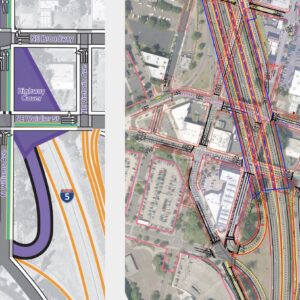


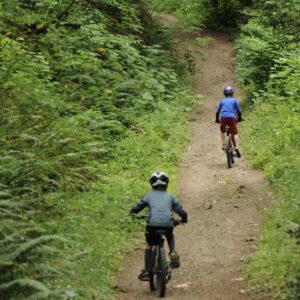
Thanks for reading.
BikePortland has served this community with independent community journalism since 2005. We rely on subscriptions from readers like you to survive. Your financial support is vital in keeping this valuable resource alive and well.
Please subscribe today to strengthen and expand our work.
Good stuff Jonathan. I think your critique of Smith’s “broad vs. deep” dichotomy is right. Sadly it looks in some cases that it is boulevards vs. trails vs. cyclotracks. Instead it should be a recognition that all tools are needed and are not mutually exclusive. The core problem is funding. So long as so little is contributed we are forced to struggle between facilities we all need and want.
For benchmarks I agree. Interim goals are critical. I’d also like to see benchmarks on the mode split too! The 25% of trips should be take by people that look like all of Portland.
Nice write up. Thanks!
Thanks for the reminder, Jonathan.
Jonathan,
Your post hit all the right notes on what is lacking in the bike plan. While the effort is admirable and conceptually the plan prescribes all the right policies it lacks a bold vision. Lacking this bold vision it is difficult in my experience to generate any public or political support for substantial increases in public spending on any public infrastructure. While the plan for transportation modeling purposes needs to look out to 20 years, a shorter plan implementation horizon is essential. In my practice, we view plans much like a gallon of milk- they have freshness dates. Great plans are implemented in 5-10 years. Beyond that point, conditions have changed substantially enough to invalidate any plan. A longer term plan often is an excuse to not make hard decisions but rather an excuse to push them off into the future. One of these hard decisions is engaging the property owners and businesses in a discussion about protected bikeways. While PDOT rightfully points out that the political support may not be there yet for protected bikeways, it raises the question- when will business owners be ready? And during what process will these groups be engaged if not during this bike planning process? In an effort to be constructive, George Crandall and myself offered Chris Smith and the other Planning Commissioners the following recommendations during a study session this week-
1. Adopt the Bike Plan as a Phase 1 effort
2. Initiate a supplemental Phase 2 Overlay planning process that emphasizes short term 5-10 year implementation strategy with an emphasis on protected bikeways
3.Establish a Copenhagen-like bold policy of a 40% bicycle mode split
4.Integrate the bike planning effort into the Portland Plan as a means to engage business and property owners and explore innovative bicycle centered land use development concepts
Good comment on the “pseudo bike boulevards” — I use northeast Davis and Everett frequently, and there are way too many stop signs. Also, pavement quality is really rough and patchy in a lot of places. It would be much improved if they made it more like Ankeny, Lincoln, Clinton, etc.
I experienced cycletracks in Stockholm and Gothenburg. In Stockholm, they were pretty awful, as they were narrow and didn’t leave much room for passing. I’d often ride on the street instead and nobody seemed to care. In Goteborg, the paths were nice and wide — Sweden’s second largest city would be a better model to emulate than the capital.
Don,
thanks for the comment.
I think what some folks might be missing is that a “bold vision” for bicycling isn’t something we should expect from PBOT. They are the government for crying out loud!
The boldness should come from activists and groups within the community. Our City bureaucrats and politicians will only be consistently bold if they are nudged and given cover for doing so by the public.
Unfortunately Portland does not have an aggressive advocacy community that is willing to question the City and push them outside of their comfort zone.
In my opinion, the people and the advocates should have a vision that is way out in front of the City… Then we’d be In a “reach for the moon and hit the stars” scenario. But right now the only ones reaching are PBOT and mayor Adams…. and we’ll simply never get to the moon that way.
Jonathan,
While you are right that constituencies are important in driving a bold vision, our city agencies have a history (and an obligation) of developing and implementing bold visions- i.e. removing the Harbor Freeway and building Waterfront Park, tearing down a parking strucutre and building Pioneer Courthouse Square, building light rail instead of the Mount Hood freeway…all first dictated as part of adopted plans.
What we are trying to do is not be critical of PDOT or the bike planning effort but rather be part of the advocacy groups that give Geller and Adams the license to be more aggressive.
Don – The examples you’re using are all at the individual project level, when what should be being discussed is a citywide approach. As individual projects, each of the developments you list – iconic and transformative as they are – do not in my opinion provide a “bold vision” for all of Portland. It’s apples to oranges.
The apples to apples comparison is between a citywide low-stress/bicycle boulevard approach and one that emphasizes cycle tracks “connecting key centers around the City…[and that] enjoy physical separation” (Chris Smith’s language). I think it’s disingenous to call the latter vision “bolder” than the former. They’re distinctly different visions, to be sure, but both represent a citywide vision for Portland that, when achieved, will represent a transformation of culture, landscape, land use, politics and policy.
The proportion of Portland’s residents who currently have easy access to low-stress bikeways connecting them to all of their essential services is embarassingly small. And yet, residents in areas that are served by these types of infrastructure demonstrate the highest bicycle mode splits in all of Portland. As such, I fail to see how expanding the access to and connectivity of low-stress bikeways to all Portlanders – that is, providing them the same level of safety and comfort that the most bike-friendly areas of Portland currently enjoy – could be considered anything other than bold.
David,
While you are right that I identified individual projects, most of these were part of the bold 1975 Central City plan that launched the legendary status of Neil Goldschmidt. As far as a citywide approach, folding in a phase 2 bike planning effort into the Portland Plan would address this concern.
Not very bold at all. Sidney is building 200km of cycle tracks in 3 years and spending $76 million in the process. In Vancouver, council has said the priority going forward is protected bike lanes (cycle tracks). The initial plan should be rolled out soon.
Bike boulevards are great but the cycle tracks are essential as well. Just like cities would not think of having a street without a sidewalk, they should not have roads without good cycling facilities.
The thing about bike boulevards is that most of these streets are already safe to ride on and don’t need much work; IMO PDOT tends to make a big deal about bike boulevards and then overdevelops them.
Bike boulevards are great if you want to ride around your neighborhood, but they don’t go to or through many destinations served by arterial streets like commercial zones that cyclists want safe access to, nor do they do an adequate job of connecting the various disparate parts of town that are only connected together by higher level arterial streets.
I’m not a huge fan of cycle tracks either, but that’s because they still have some serious design flaws that need to be resolved before they are placed into widespead use.
I’m a much bigger fan of sharrows, which send a clear message to motorists that cyclists belong on and are allowed to use arterial streets, and not just when there is a substandard width, door-zone, right-hook, debris, utility cut and drainage-grate filled bike lane present.
What PDOT really needs to do is give the sacred cow that is curbside parking a good swift kick in the butt, and proiritize the streets for moving people on human powered vehicles, and not for motor vehicle storage.
What PDOT really needs to do is give the sacred cow that is curbside parking a good swift kick in the butt, and prioritize the streets for moving people on human powered vehicles, and not for motor vehicle storage.
Right! Now we just have to convince all of the business districts and associations that this won’t kill their business. I think that’s our challenge moving forward. It’s what stands in the way of making, for instance, Hawthorne Blvd a 2 lane blvd with cycletracks in either direction. The businesses don’t want it. I want to sympathize with them because I don’t think they are being anti-bike, they’re just looking out for the future viability of their business.
Perhaps when we do enough of this ‘deep’ improvement, we’ll have the clout that will convince business owners to support more radical changes like removing parking.
I like the 5 by ’15 idea. We need to increase the percentage of the transportation budget being spent on bicycle infrastructure. 5% of the budget as of 2015. #3, I like all of your ideas. The Portland Plan and the Bicycle Master Plan should be integrated.
if you get rid of onstreet parking on Hawthorne you will not need a cycletrack, just assert the outer lane.
While I like the plan well enough, what I don’t get is how it mitigates against, for example, the removal of pedestrian space in favor of creating bike lanes on Burnside. If the city’s overall goal is to provide its residents with options and alternatives to driving or SOV-travel, that doesn’t strike me as a step in the right direction. I don’t think the majority of cycling advocates or a significant percentage of people who currently bike want growth in cycling to come at the expense of people who walk, but when push comes to shove, the opposition to removing on-street parking and, often, to removing motorized travel lanes wins out more often than not.
I guess it’s not the plan I worry about, it’s the process of how the plan gets implemented — and how it gets ignored when the politics get difficult.
Try not to assume that removing car parking is insurmountable. I experienced very little resistance on Belmont St. when first canvassing for the bike corrals.
There are true business benefits to less car-centric streets; as well as bonafide public safety improvements.
And this was early 2007 … these are more enlightened times, no?
I agree with Jonathan that we need to present more ideas that are bold, and help provide direction to our leaders.
construction of curb extensions is a clear benefit for both pedestrians and motorists who want curb side parking, at the expense of cyclists; if you review what’s been built in Portland over the last 10 or 20 years, basically pedestrians and cyclists have been fighting over the left-over scraps after the motorists have been taken care of, and the pedestrians usually come out on top.
if the curb extension narrows the street, take the lane
Create a wave, and politicians will ride.
Boldness is more cyclists taking the lane. “Take it easy, but take it”…W. Guthrie
Curb extensions are a reminder that you are riding too far to the right.